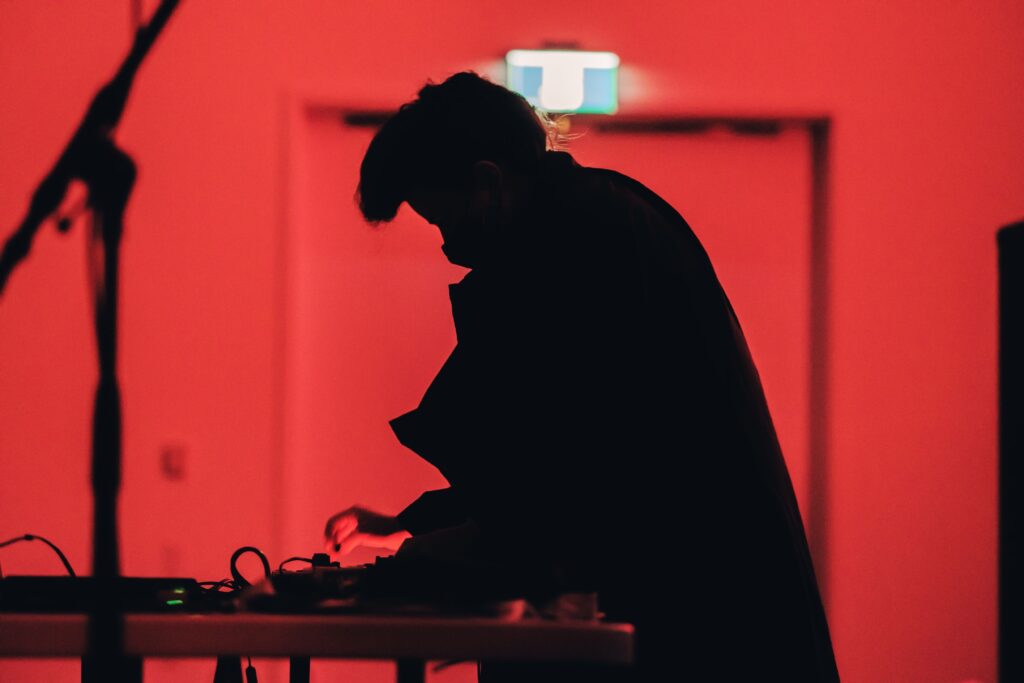Ecuadorian Nicola Cruz has built his reputation as one of the pioneers of cutting-edge electronic music in Latin America, notably by integrating fragments of local, Andean, indigenous, Afro-Latin, and tropicalist folk music into his creations with the most refined electronic aesthetics.
He is known for several recordings, including “Sentimientos Encotrados”(fall 2021) and the new EP “Self Oscillation” (July 2022). A regular at MUTEK, Nicola Cruz returns with new material the day after a partially rainy DJ set at the Esplanade tranquille. This too wet moment of the Experience series is now a thing of the past, let’s make way for the main course! Nicola Cruz performs this Wednesday at SAT, he is the central artist of this first program of the Nocturne series.
PAN M 360: We know that Nicola Cruz is close to her Latin American roots and has her eye on the future. Of course, this description is reductive and doesn’t tell us where you are at. How far have you come since your time at MUTEK in the summer of 2019?
NICOLA CRUZ: I’m always trying new concepts, trying to evolve my sound and my curiosities, and not always sticking to one thing. So exploring traditional instrumentation and other aspects of Ecuadorian culture is an earlier phase of my work. Today I think I’m moving towards a synthesis of what I’ve learned, towards exploring the sound at a deeper level, while keeping this idea of ritualizing my work in the studio and, therefore, ritualizing my composition.
PAN M 360: And how is this ritualization embodied?
NICOLA CRUZ: I’m trying to find a specific example, but Wednesday’s set will be a little more explanatory than the words coming out of my mouth right now. There are composed structures and there is also improvisation as there is always in my live sets.
PAN M 360: If we try to understand, you draw from your whole bank of sounds and you propose new ones among this collection, to suggest new ways to express your art.
NICOLA CRUZ: Exactly. When you make electronic music, it’s not like picking up a guitar, you have to draw from a whole bunch of stuff. That’s true. That’s the creative and interesting part of presenting electronic music, right? So of course I always leave room for improvisation, whether it’s with the modular, with a drum machine, with a synthesizer or other instrument. But there is also that part of the music that results from studio work and programming, about choosing the direction of a piece.
Right now, for example, I’m planning to start a new album that will be released next year. So I don’t present a certain concept and I don’t shoot the music for the album. In fact, I never tour to present the material of an album, because I am always transforming my show in real time.
PAN M 360: Yes indeed, you change your sound often and that’s what makes your music interesting and creative. We’ve heard your integrations of indigenous music from Central or South America, especially, but as you suggest, that’s not a goal in itself. Sometimes this component is present, sometimes it is not.
NICOLA CRUZ: Yes. Avoiding clichés about the cultural/stylistic elements of my music as an objective or concept is very important to me. You can’t overuse concepts, nothing should be obvious or redundant.
PAN M 360: Yes, only the result matters. Defining it on the basis of cultural origins and intellectualizing it too much can be a trap. You can look for roots where they are not…
NICOLA CRUZ: Exactly. You know, I think it’s also the fault of the Western media in search of exoticism, which too often seeks to illustrate this cliché of Latin roots in my work. That’s a colonialist approach as far as I’m concerned. Even though I have included a lot of traditional music and instruments in my music, I have never felt identified with this idea of consciously displaying my roots.
PAN M 360: It comes naturally, it often comes from the unconscious and you don’t have to make more of it, build up false theories.
NICOLA CRUZ: I totally agree. Personally, I’ve always done techno and house music before I even started composing and getting interested in breakbeats and really exploiting electronic music in its technological subtleties. So I feel like life is leading me somewhere along there, as I explore my music and its roots while leveraging the power of technology. Also, I’ve never been afraid to use melodies, my latest compositions are very melodic and I’m also interested in psychedelia to add a new flavor and go further.
PAN M 360: And this Wednesday?
NICOLA CRUZ: I’m performing with a video artist from New York. There is no specific concept, I’m here to present my new creative flow, I can’t say more than that. Of course there will be lots of new sounds, some of which will be created live. I think in terms of sounds, my work has become very detailed and expressive. I actually like who I am musically now. I feel like I’m conveying a lot, it’s quite emotional and also very danceable.
PAN M 360: Is the duty to make people dance a problem?
NICOLA CRUZ: It varies but it’s still voluntary when I do it. I still want to make dance music, I was a DJ and I still am. So what I’m doing now is danceable. It’s also a kind of reconnection with what I started with electronic music which was techno and house, which is still very interesting territory.
NICOLA CRUZ PERFORMS THIS WEDNESDAY AT SAT, NIGHT SERIES 1 / MUTEK MONTREAL.


